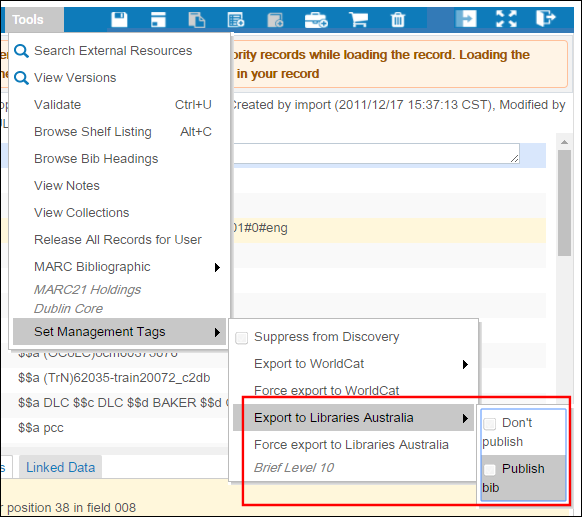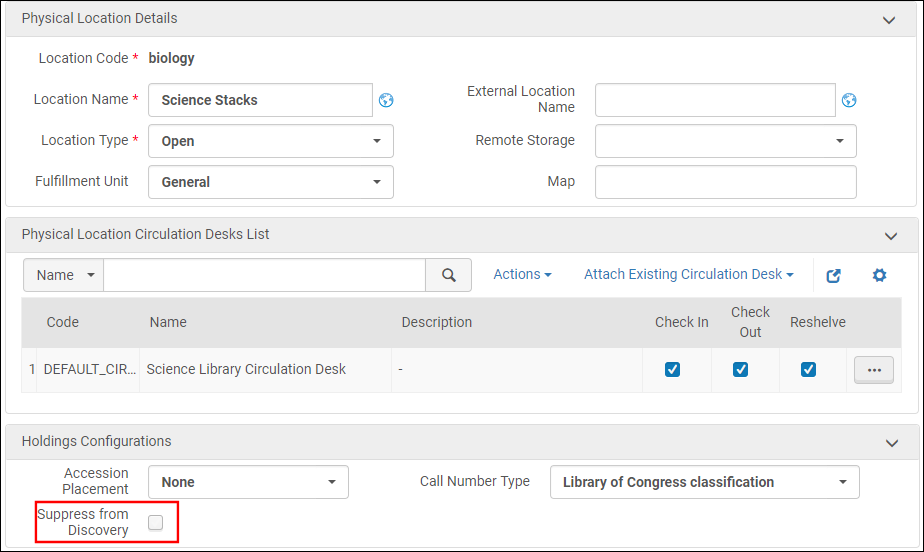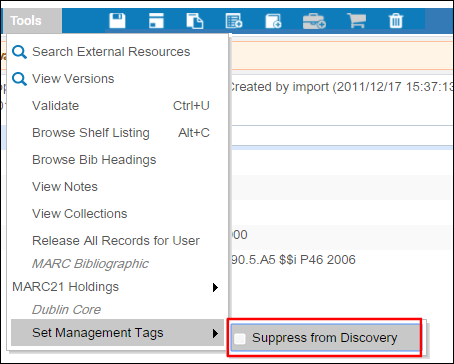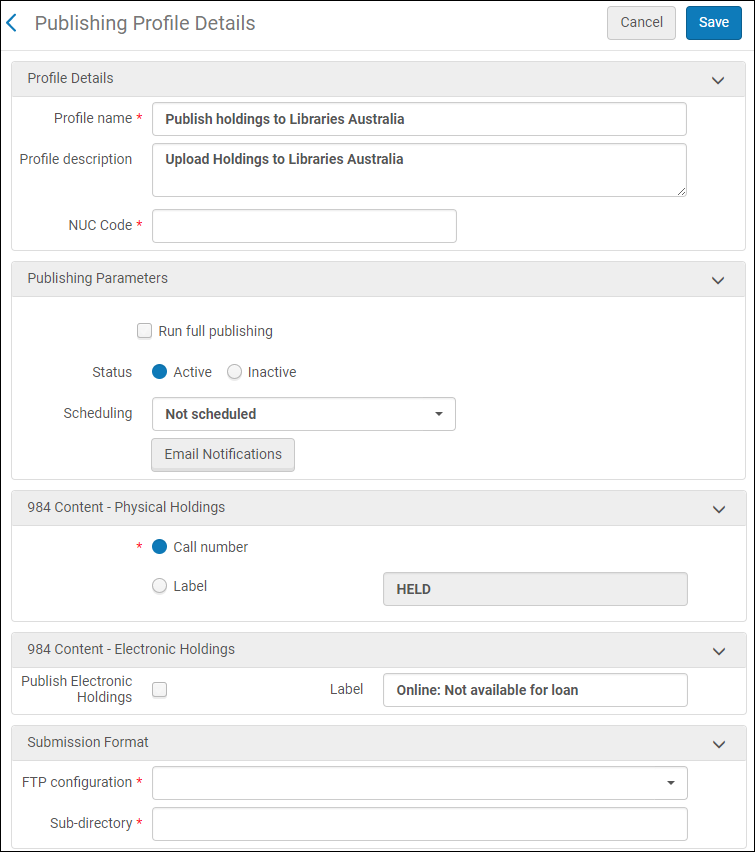Publishing to Libraries Australia
- Catalog Administrator
- Repository Administrator
- General System Administrator
Overview of Publishing to Libraries Australia
- The bibliographic record is set or marked to be published, which can be handled in the following manner:
- The record is set to Publish bib in the MD Editor (Tools > Set Management Tags > Export to Libraries Australia) as shown in the figure below.
If the same record is subsequently set to Don’t publish in the MD Editor, Alma supports publishing this record to the LA so that the LA is synchronized to know that this is a suppressed record.
 Manually Publish or Force ExportAdditionally, holdings records can be marked for suppression by the following methods:Out-of-the-box Libraries Australia publishing profile will only work with an unsuppressed location.
Manually Publish or Force ExportAdditionally, holdings records can be marked for suppression by the following methods:Out-of-the-box Libraries Australia publishing profile will only work with an unsuppressed location.- Location configuration
On the Edit Physical Locations page (Configuration Menu > General > (select the correct location in configuring) > Locations > Physical Locations; select Edit in the row actions list for the relevant location), select Suppress from Discovery.
 Location Configuration Suppress from Discovery OptionUsing the MD EditorMark an individual holdings record for suppression in the MD Editor by selecting Tools > Set Management Tags > Suppress from Discovery when the holdings record to be suppressed is the active record on the MD Editor page.
Location Configuration Suppress from Discovery OptionUsing the MD EditorMark an individual holdings record for suppression in the MD Editor by selecting Tools > Set Management Tags > Suppress from Discovery when the holdings record to be suppressed is the active record on the MD Editor page. Suppress from Discovery Option for a Holdings Record
Suppress from Discovery Option for a Holdings Record
- Location configuration
- Running the Synchronize MMS with national catalog job to mark records to publish in bulk. For more information, see Running Manual Jobs on Defined Sets and step 2 of To do an initial publishing with Libraries Australia:.
- Records can be marked to publish to Libraries Australia as part of the record import process using an import profile. (This is the recommended practice when the import will result in records ready to publish to Libraries Australia, to ensure an optimal, ongoing update process for Libraries Australia.) For more information, see Creating/Editing an Import Profile: Set Management Tags.
- The record is set to Publish bib in the MD Editor (Tools > Set Management Tags > Export to Libraries Australia) as shown in the figure below.
- The bibliographic record or any holdings record linked to the bibliographic record changed since the last time it was published, or a staff user has manually selected the record to be exported, which is also known as forced export. (Select Force export to Libraries Australia from the MD Editor’s Tools > Set Management Tags menu, refer to the figure below.)
- The appropriate publishing profile has been properly defined and enabled (refer to the procedure To configure the Libraries Australia publishing profile:).
| File Name Component | Description |
|---|---|
| NUC_CODE | The NUC code as identified in the configuration. |
| process type |
|
| format.id | The format ID of D (data) is used. sequence The sequence is a running number of file uploads. The numbers are recycled after reaching the upper limit (99). The last sequence number used is saved as part of the publishing profile. When the sequence number reaches 99, it restarts with 00. |
- Local fields (59X and 9XX) are excluded from the record to be published.
- If 019 $a exists, the contents of the 019 $a are written to the 001 field in the export file. If there is no content for 019 $a, the 001 field is removed.
- The value of the Alma MMS ID (from 001) is copied to the 035 $a
There is only one 035 field in the export files (that contains the MMS ID in $a) except for instances where (OCoLC) is specified in the other 035 $a.
- The 090 and 091 fields and $9s are omitted.
- The 852 field is retrieved from the holdings record.
- The NUC code is retrieved from one of the following:
- The library NUC code mapping table
- The configured institution NUC code
- A new 984 field is added to the bibliographic record.
- The 984 $a is set to the NUC code retrieved above.
- The 984 $c is set with either the normalized value of the call number from the holdings record or the label value such as HELD as set on the Publishing Profile Details page (see To configure the Libraries Australia publishing profile).
-
When a bibliographic record is deleted or suppressed from publishing to LA, it contains d in the leader position 5 and deleted is specified in the 984 $c (see the example below).<datafield tag="984" ind1=" " ind2=" ">
<subfield code="a">SUA:A</subfield>
<subfield code="c">deleted</subfield>
</datafield>
<datafield tag="984" ind1=" " ind2=" ">
<subfield code="a">SUA:B</subfield>
<subfield code="c">deleted</subfield>
</datafield>
<datafield tag="984" ind1=" " ind2=" ">
<subfield code="a">SUA:C</subfield>
<subfield code="c">deleted</subfield>
</datafield> - When one holdings record is deleted, all other holdings will be published as an update.
- When one holdings record is updated, only this updated holdings record will be published with the new information.
- When bibliographic record information is changed, all holdings which are not deleted will be published as an update.
- There can be repeating subfields. In the example below, $c and $d are repeating entries. Other subfields, determined by your mapping, may be repeating subfields.
<datafield tag="984" ind1=" " ind2=" ">
<subfield code="a">NUC_TEST</subfield>
<subfield code="c">MICROFILM 3502-3508 </subfield>
<subfield code="d">Vol. 1 (1967)-v. 7 (1974)</subfield>
</datafield>
<datafield tag="984" ind1=" " ind2=" ">
<subfield code="a">SUA-R</subfield>
<subfield code="c">JJ73397-73400 </subfield>
<subfield code="d">Vol. 8 (1974)-v. 11 (1978)</subfield>
<subfield code="c">375.905 H674 </subfield>
<subfield code="d">Vol. 1, no. 1-v. 37, no. 4 (Nov. 1967-Aug. 2004)
</subfield>
</datafield> - Other 984 subfields are set according to the configured mapping information (see To configure the holdings mapping for Libraries Australia).
- When multiple holdings exist, the output is one 984 per NUC, where the $a contains the NUC code, the $c is repeatable with the call number of all the holdings for that NUC/library. Other subfields, that are mapped from the mapping table, are repeatable, too.
Note that if the Upload Holdings to Libraries Australia job fails, the records that are marked for publishing will continue to remain marked for publishing until the Upload Holdings to Libraries Australia job runs successfully. This is true even if you run the Synchronize MMS with National Catalog job before running the Upload Holdings to Libraries Australia job again. The synchronization job does not remove the publishing indication/flag (publish or don’t publish), that is, unless someone in the interim actually changed the flag. The job report that is available for the failed job should also be referenced for indications of what happened such as errors, skipped records, and FTP issues.
Publishing Related Records to Libraries Australia
Initial Publishing to Libraries Australia
- Communicate with Libraries Australia to let them know that you will be running an initial publishing of records from Alma and prepare any profile configurations that need to be coordinated between your institution and Libraries Australia.
- Mark the bibliographic records that you want published to Libraries Australia using the MD Editor (see the information provided under Overview of Publishing to Libraries Australia)
Alternatively, run the Synchronize MMS with national catalog job to mark one or more sets of records; for more information, see Running Manual Jobs on Defined Sets
- Identify the holdings records to be published. More specifically, mark the holdings records that you want suppressed. You can suppress holdings records, as a group, based on their location; or you can suppress individual records using the MD Editor. See Location configuration and Using the MD Editor for more information.
- Configure your Libraries Australia publishing profile. See Libraries Australia Publishing Profile (the next section) with particular attention to the following:
- Select Run full publishing for your initial upload.
(After Alma has successfully completed running your initial load, it removes the Run full publishing selection in your profile in preparation for you to move on to the ongoing phase of publishing.)
- Select Not Scheduled from the drop-down list for your scheduling option. You will want to confirm with Libraries Australia the success of your initial load before setting the publishing profile to run automatically.
- Confirm that you have an FTP configuration created that addresses your requirements.
- Select Run full publishing for your initial upload.
- Run your initial load publishing job.
- Access the Upload Holdings to Libraries Australia publishing profile that you have configured (Resources > Publishing > Publishing Profiles).
- Select Run from the row actions list.
- Confirm with Libraries Australia that your initial load has completed successfully.
- Configure your Upload Holdings to Libraries Australia publishing profile for the ongoing publishing of your records to Libraries Australia.
Libraries Australia Publishing Profile
- On the Publishing Profiles page (Resources > Publishing > Publishing Profiles), select Edit in the row actions list for Publish holdings to Libraries Australia. The Publishing Profile Details page appears.
-
 Publishing Profiles Details Page
Publishing Profiles Details Page - Edit the profile details to match your requirements (see the table below for a description of the options).
Publishing Profile Details Page Description Option Description Profile Details: NUC code
Enter the code/symbol by which the institution is identified to the Libraries Australia.
For a library or library and location (with a NUC symbol that is different from the institution’s, the symbol needs to be specified in the Symbol field located in the Institution NUC Symbol configuration (Resource Management > Resource Configuration > Configuration Menu > Record Export > Institution NUC symbol). The symbol specified in the Symbol field overrides what is specified in the NUC Code field on the Publishing Profile Details page.
 Institution NUC Symbol Mapping Table
Institution NUC Symbol Mapping TablePublishing Parameters: Run full publishing Select this to complete your initial publishing to Libraries Australia. See Initial Publishing to Libraries Australia for more information. Once the initial publishing is complete, Alma automatically removes the Run full publishing check box selection for this profile to enable it to be used for the ongoing publishing of records to Libraries Australia.Status Specify the status of the profile as active or inactive. Only active profiles will be run.Scheduling Select a scheduling option. Email Notifications Specify which users and email addresses will receive email notifications when the publishing profile has completed. 984 Content - Physical Holdings: Call number or Label Select the Call number option for the call number to be mapped for export. Alternatively, select the Label option and enter a label in the field next to this option to have the label you entered be mapped for export. In the example below, HELD is mapped for export (indicating that the institution/library has holdings).984 Content - Electronic Holdings: Publish Electronic Holdings / Label Select the Publish Electronic Holdings option to publish holdings to Libraries Australia, and enter the label content that you want to appear for the electronic holdings. The default label content for this parameter is Online: Not available for loan. This capability is effective for electronic holdings that are published to Libraries Australia when the electronic holdings bibliographic records are new or updated and are flagged with the Export to Libraries Australia set management tag set to Publish bib.Submission Format: FTP configuration Specify the FTP configuration to use. Select the FTP configuration that contains the appropriate server, port, user name, and password for the connection (see Configuring S/FTP Connections). Subdirectory An optional subdirectory in which the files should be placed for the FTP upload. For example, if you specified Alma in the Sub-directory field during S/FTP connection configuration and you enter LA in this field, the data is exported to the Alma/LA directory. - Select Save.
The next time that the Libraries Australia publishing profile is run with the Physical Holdings and Electronic Holdings parameters selected, the records are handled in the following manner:
- Alma creates one 984 field and all the associated holdings information for records that have both electronic and physical holdings with the same NUC code. For example:
984 $a NSL $c M Q823.912/ W187.1/ 4 $c Online: Not available for loanThe first $c holds the physical information, and the second $c holds the electronic information. Since the electronic holdings do not have call numbers, only the label is published in $c for the electronic holdings.See the next section Holdings Mapping for Libraries Australia for more information.
- Mapping of the NUC is handled in the following manner:
- If the portfolio has an owning library, the owning library’s NUC is used.
- If there is no portfolio owning library NUC, the NUC of the collection’s owning library is used.
- If there is no portfolio or collection owning library NUC, the default NUC identified in the NUC Code parameter of the publishing profile is used.
- Only active portfolios are processed for publishing.
- A NUC is sent as deleted only when all the holdings (both print and electronic) are deleted. When only the print holdings is deleted, the records are sent as updated with only the electronic holdings.
- Alma creates one 984 field and all the associated holdings information for records that have both electronic and physical holdings with the same NUC code. For example:
Holdings Mapping for Libraries Australia

| Option | Description |
|---|---|
| Target Code | A unique code to identify the row. |
| Holdings Tag (field) | The holdings MARC field from which the content is to be mapped to the bibliographic MARC field. |
| Holdings Subfield | The subfield from which the content is to be mapped for the export file. The following 852 subfields are ignored: h, i, j, k, l, and m. |
| Bibliographic Tag (field) | The bibliographic MARC field to be mapped for the export file. By definition, this is the 984 field. |
| Bibliographic Subfield | The subfield that will contain the content of the mapped holdings subfield. Libraries Australia's RIS documentation specifies the following allowed subfields: d, e, f, g and h. Subfield a and c are automatically mapped by the publishing process and do not require configuration here. |

